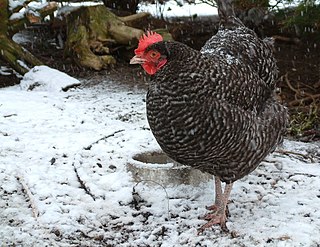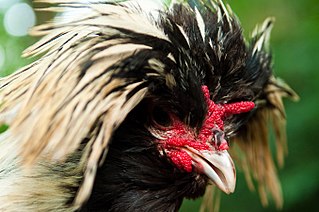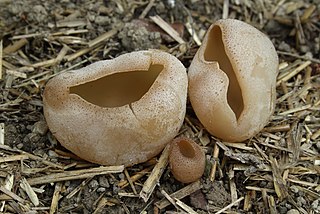
The Barnevelder is a Dutch breed of domestic chicken. It resulted from cross-breeding between local Dutch chickens and various "Shanghai" birds imported from Asia to Europe in the later part of the nineteenth century; these may have been of Brahma, Cochin or Croad Langshan type. It is named for the town and gemeente (municipality) of Barneveld, in Gelderland in the central Netherlands. The hens are good layers of large brown eggs and, unlike some other breeds, continue to lay well during winter.

The Pekin Bantam is a British breed of bantam chicken. It derives from birds brought to Europe from China in the nineteenth century, and is named for the city of Peking where it was believed to have originated. It is a true bantam, with no corresponding large fowl. It is recognised only in the United Kingdom, where the Cochin has no recognised bantam version; like the Cochin, it has heavy feathering to the legs and feet. The Entente Européenne treats the Pekin Bantam as equivalent to the bantam Cochin.

The Marans, French: Poule de Marans, is a French breed of dual-purpose chicken, reared both for meat and for its dark brown eggs. It originated in or near the port town of Marans, in the département of Charente-Maritime, in the Nouvelle-Aquitaine region of south-western France.

Russula cyanoxantha, synonymous with R. xyanoxantha, commonly known as the charcoal burner or variegated russula, is a basidiomycete mushroom, distinguished from most other members of the genus Russula by the fact that its gills do not split, but are soft and flexible. It is one of the most common species of Russula in Europe.
The Croad Langshan is an old, heavy, soft-feathered chicken breed which probably originated in China.

The Polish or Poland is a European breed of crested chickens known for its remarkable crest of feathers. The oldest accounts of these birds come from The Netherlands; their exact origins are unknown, however. In addition to combs, they are adorned with large crests that nearly cover the entirety of the head. This crest limits their vision, and as a result can affect their temperament. Thus, though normally tame, they may be timid and easily frightened.

The Jersey Giant is an American breed of domestic chicken. It was created in Burlington County, New Jersey, in the late nineteenth century. As the name suggests, it is a large breed, and is among the heaviest of all chicken breeds.

Cortinarius collinitus, commonly known as the belted slimy cortinarius, is a species of fungus in the family Cortinariaceae.

Lyophyllum decastes, commonly known as the fried chicken mushroom, or chicken of the gravel, is an edible species of fungus in the family Lyophyllaceae that grows in clusters on disturbed ground, often near man-made roads in gravel, with a faintly radish-like taste.

Amanita magniverrucata, commonly known as the pine cone amanita, or great pine jewel, is a species of agaric mushroom in the family Amanitaceae. First described scientifically by American mycologists Harry Delbert Thiers and Joseph Ammirati in 1982, it is mycorrhizal and associates with the tree Pinus radiata.

Otidea alutacea is a species of apothecial fungus belonging to the family Pyronemataceae. This European species appears as buff coloured deep cups, often split down one side, up to 6 cm tall, on soil in woodland. It is inedible.

The Australian Langshan is an Australian chicken breed, derived from the Croad Langshan and accepted by the Australian Poultry Standard as a recognized breed. The Australian Langshan is little known outside Australia but is a popular breed inside the country. The breed comes in both bantam and standard size.

Legaliana badia is a species of apothecial fungus belonging to the family Pezizaceae. This is one of the more familiar of the cup fungi of Europe, appearing as irregular dark brown cups up to 8 cm in diameter, often in small groups, on soil in woodland. The species tends to be seen more frequently on sandy soils and favours bare ground, e.g. at the sides of paths. This is a frequently observed European species with scattered records from many other parts of the world. It is not edible.

Peziza succosa is a species of apothecial fungus belonging to the family Pezizaceae. It grows in woods in Europe, Iceland, Israel, China, Argentina, and the United States. In Europe this fungus appears in summer and autumn as grey or brown saucers up to 10 cm (3.9 in) in diameter on soil in woodland, often at pathsides. In the United States, this type of cup fungi may also be found on decaying deciduous wood. It is inedible.

Peziza vesiculosa is a species of apothecial fungus belonging to the family Pezizaceae. This is a common species of Europe, with scattered records in other parts of the world. The pale, cup-shaped ascocarps can grow quite large and often form densely packed groups. It is found on nutrient-rich soils, rotting straw and manure and can often be seen on compost heaps. The species is considered poisonous. It is difficult to identify without microscopy.

Scutellinia umbrorum is a species of apothecial fungus belonging to the family Pyronemataceae. This is a common European species, forming clusters of orange discs up to 1.5 cm in diameter on soil or rotting wood in summer and autumn. It is very similar to congeners such as Scutellinia olivascens and can only be reliably identified by microscopic features. S. umbrorum is inedible.

Solid black plumage color refers to a plumage pattern in chickens characterized by a uniform, black color across all feathers. There are chicken breeds where the typical plumage color is black, such as Australorp, Sumatra, White-Faced Black Spanish, Jersey Giant and others. And there are many other breeds having different color varieties, which also have an extended black variety, such as Leghorn, Minorca, Wyandotte, Orpington, Langshan and others.
The Modern Langshan is a breed of chicken derived from the Croad Langshan. Though today it is rarely seen, the breed was at one time fairly popular.
The chicken breeds recognized by the American Poultry Association are listed in the American Standard of Perfection. They are categorized into classes: standard-sized breeds are grouped by type or by place of origin, while bantam breeds are classified according to type or physical characteristics.

The Frizzle is a breed of chicken with characteristic curled or frizzled plumage. While the frizzle gene can be seen in many breeds, such as the Pekin and Polish, the Frizzle is recognised as a distinct breed in a number of European countries and Australia. In the United States frizzled chickens are not considered a breed, and at shows are judged by the standards of the breed they belong to.



















